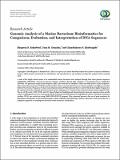Por favor, use este identificador para citar o enlazar a este item:
http://hdl.handle.net/10261/141395COMPARTIR / EXPORTAR:
 SHARE SHARE
 CORE
BASE CORE
BASE
|
|
| Visualizar otros formatos: MARC | Dublin Core | RDF | ORE | MODS | METS | DIDL | DATACITE | |

| Campo DC | Valor | Lengua/Idioma |
|---|---|---|
| dc.contributor.author | Rekadwad, Bhagwan N. | es_ES |
| dc.contributor.author | González Grau, Juan Miguel | es_ES |
| dc.contributor.author | Khobragade, Chandrahasya N. | es_ES |
| dc.date.accessioned | 2016-12-14T06:31:25Z | - |
| dc.date.available | 2016-12-14T06:31:25Z | - |
| dc.date.issued | 2016-10 | - |
| dc.identifier.citation | BioMed Research International Volume 2016 Article ID 7215379, 7 pages (2016) | es_ES |
| dc.identifier.uri | http://hdl.handle.net/10261/141395 | - |
| dc.description | 7 páginas.-- 3 figuras.-- 2 tablas.-- 15 referencias | es_ES |
| dc.description.abstract | A total of five highly related strains of an unidentified marine bacterium were analyzed through their short genome sequences (AM260709–AM260713). Genome-to-Genome Distance (GGDC) showed high similarity to Pseudoalteromonas haloplanktis (X67024). The generated unique Quick Response (QR) codes indicated no identity to other microbial species or gene sequences. Chaos Game Representation (CGR) showed the number of bases concentrated in the area. Guanine residues were highest in number followed by cytosine. Frequency of Chaos Game Representation (FCGR) indicated that CC and GG blocks have higher frequency in the sequence from the evaluated marine bacterium strains. Maximum GC content for the marine bacterium strains ranged 53-54%. The use of QR codes, CGR, FCGR, and GC dataset helped in identifying and interpreting short genome sequences from specific isolates. A phylogenetic tree was constructed with the bootstrap test (1000 replicates) using MEGA6 software. Principal Component Analysis (PCA) was carried out using EMBL-EBI MUSCLE program. Thus, generated genomic data are of great assistance for hierarchical classification in Bacterial Systematics which combined with phenotypic features represents a basic procedure for a polyphasic approach on unambiguous bacterial isolate taxonomic classification. | es_ES |
| dc.language.iso | eng | es_ES |
| dc.publisher | Hindawi Publishing Corporation | es_ES |
| dc.relation.isversionof | Publisher's version | es_ES |
| dc.rights | openAccess | es_ES |
| dc.title | Genomic Analysis of a Marine Bacterium: Bioinformatics for Comparison, Evaluation, and Interpretation of DNA Sequences | es_ES |
| dc.type | artículo | es_ES |
| dc.identifier.doi | 10.1155/2016/7215379 | - |
| dc.description.peerreviewed | Peer reviewed | es_ES |
| dc.relation.publisherversion | http://dx.doi.org/10.1155/2016/7215379 | es_ES |
| dc.rights.license | https://creativecommons.org/licenses/by/4.0/ | es_ES |
| dc.relation.csic | Sí | es_ES |
| oprm.item.hasRevision | no ko 0 false | * |
| dc.identifier.pmid | 27882328 | - |
| dc.type.coar | http://purl.org/coar/resource_type/c_6501 | es_ES |
| item.grantfulltext | open | - |
| item.cerifentitytype | Publications | - |
| item.openairecristype | http://purl.org/coar/resource_type/c_18cf | - |
| item.languageiso639-1 | en | - |
| item.fulltext | With Fulltext | - |
| item.openairetype | artículo | - |
| Aparece en las colecciones: | (IRNAS) Artículos | |
Ficheros en este ítem:
| Fichero | Descripción | Tamaño | Formato | |
|---|---|---|---|---|
| Rekadwad_Genomic_Analysis_Marine_Bacterium_2016.pdf | 2,5 MB | Adobe PDF |  Visualizar/Abrir |
CORE Recommender
PubMed Central
Citations
3
checked on 06-mar-2024
SCOPUSTM
Citations
4
checked on 15-abr-2024
WEB OF SCIENCETM
Citations
1
checked on 26-feb-2024
Page view(s)
312
checked on 15-abr-2024
Download(s)
176
checked on 15-abr-2024

